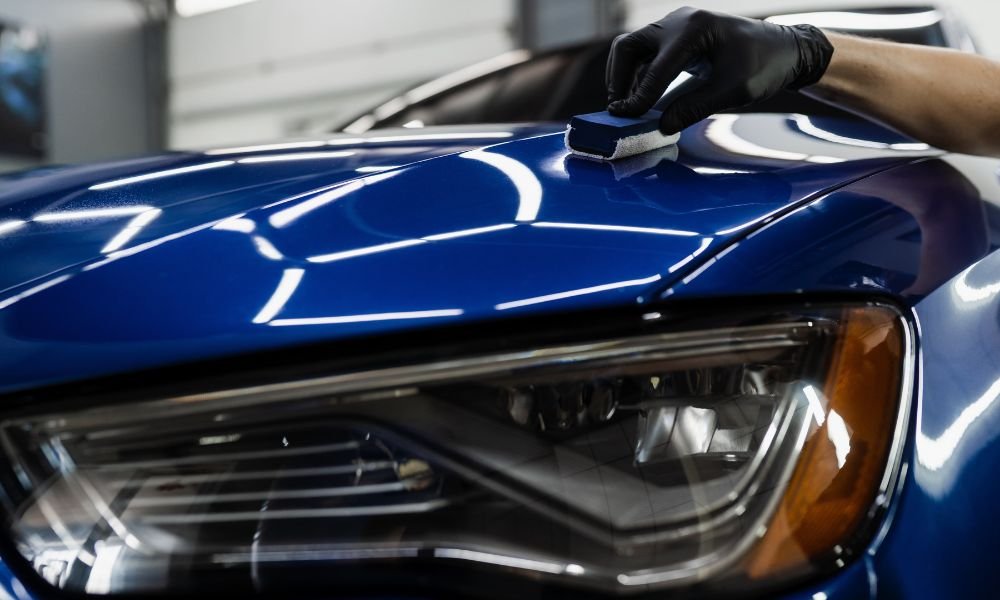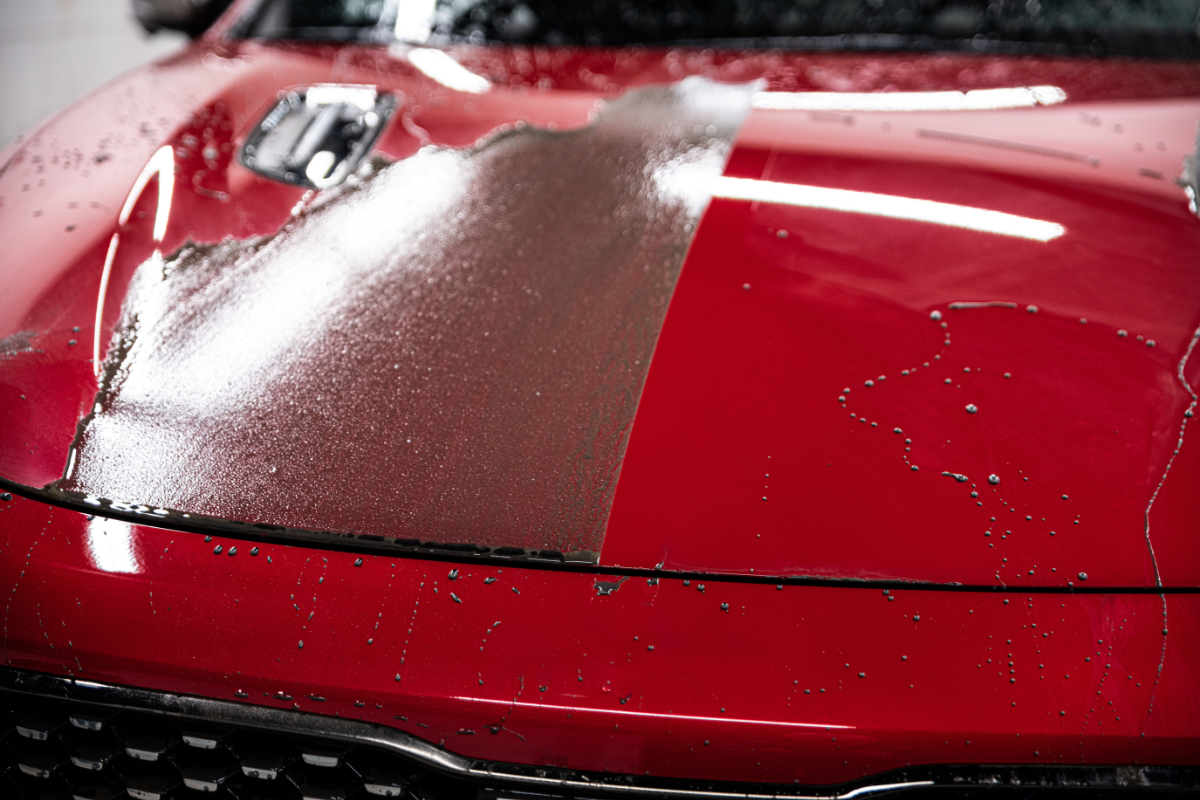Ceramic Coating vs. Sealants: Understanding the Distinctions for Your Auto
Ceramic Coating vs. Sealants: Understanding the Distinctions for Your Auto
Blog Article
The Importance of Ceramic Coating: Safeguarding Your Vehicle's Outside With Accuracy
In an era where preserving the practical and aesthetic stability of your lorry is critical, ceramic finish emerges as a pivotal remedy. With its one-of-a-kind bonding residential or commercial properties, ceramic finishing offers a level of defense that far exceeds conventional waxing techniques.
Advantages of Ceramic Coating
When it comes to maintaining a cars and truck's visual charm, ceramic covering provides substantial benefits. By developing a semi-permanent bond with the car's paint, ceramic coverings effectively prevent oxidation and fading, making certain that the cars and truck preserves a glossy, showroom-like coating for a prolonged period.
Along with its safety high qualities, ceramic covering offers impressive hydrophobic homes, causing water and various other fluids to bead off easily. This feature streamlines the cleaning procedure, as dirt and debris are less most likely to follow the surface area, decreasing the regularity and initiative required for upkeep. In addition, the covering's resistance to chemical spots from acidic pollutants like bird droppings and tree sap is another significant benefit, reducing potential paint damages.
Ceramic coatings also improve scratch resistance, giving a layer that can absorb minor abrasions and swirl marks. This feature is particularly valuable in maintaining a beautiful surface area, reducing the possibility of noticeable blemishes and preserving the integrity of the cars and truck's paintwork over time.

How Ceramic Finishing Functions
Recognizing the mechanics behind ceramic covering exposes its efficiency as a safety solution for vehicles. Ceramic coverings are basically fluid polymer applications that chemically bond with a vehicle's factory paint, producing a protective layer. This layer works as an obstacle against environmental pollutants such as grime, ultraviolet, and dirt rays, which can weaken an automobile's exterior in time. The crucial element in ceramic finish is silicon dioxide (SiO2), which stems from quartz crystals and is recognized for its remarkable solidity and sturdiness.
Application of ceramic coating involves a meticulous process. Originally, the lorry's surface area have to be extensively cleansed and decontaminated to ensure optimum attachment. Once used, the liquid polymer develops a semi-permanent bond with the paint, hardening right into a transparent, durable guard. This shield boosts the car's gloss and hydrophobic residential properties, promoting much easier cleansing by triggering water and contaminants to grain and slide off easily.
Additionally, the coating's molecular framework offers resistance to small scrapes and chemical stains. Unlike waxes or sealants that rest on top of the paint, ceramic coatings integrate with the surface, offering lasting security. This assimilation is fundamental to its efficiency, making certain the vehicle's surface stays immaculate for years.
Comparing Ceramic Coating to Alternatives
In the realm of vehicle security, ceramic finish stands as an awesome alternative when contrasted to standard options such as sealers and waxes. While waxes use a momentary shiny surface, usually lasting just a couple of weeks to months, ceramic coverings offer a longer-lasting option, usually sustaining for several years. This durability is connected to the chemical bonding that takes place when ceramic layers are used, developing a solid layer that is immune to ecological dangers.
Contrastingly, sealants, although even more resistant than waxes, still drop brief of the robust defense used by ceramic coverings. Sealants can normally last for as much as a year, providing an artificial guard against particular aspects. They do not have the exceptional hydrophobic properties and UV defense that ceramic finishings supply.
Additionally, ceramic coverings supply improved scrape resistance, which neither waxes nor sealers can efficiently match (ceramic coating). This is specifically helpful in maintaining an auto's beautiful look. Furthermore, ceramic layers simplify upkeep efforts by minimizing the adherence of dust and gunk, therefore helping with less complicated cleaning. In recap, while traditional waxes and sealants supply fundamental defense, ceramic coverings offer an extensive, long-term remedy that substantially maintains the car and boosts's outside finish.
Application Process Described
Using ceramic layer to a vehicle needs a precise process to guarantee optimum outcomes and resilience. The preliminary action entails completely cleaning up the auto's surface to get rid of dust, grease, and previous waxes. This is important for making certain the coating sticks properly. A pH-neutral shampoo and a clay bar treatment are typically utilized to achieve a pristine surface area. As soon as cleaned up, the car is dried and brightened to get rid of any type of imperfections, as any kind of existing swirls or scratches can become extra noticable after the finishing is applied.
Complying with surface area preparation, the application of the ceramic layer begins. The coating is commonly applied in a climate-controlled setting to stop dirt bits from deciding on the newly cleansed surface. Making use of an applicator pad, the ceramic covering is used in small areas to ensure resource even insurance coverage. It is vital to follow the maker's guidelines regarding the proper curing time and application density. official statement
After application, the finishing needs a details curing duration, throughout which the car must be safeguarded from water and pollutants. This healing process can vary relying on the product however usually ranges from 24 to 48 hours. Eventually, this in-depth procedure is crucial in attaining a resilient and glossy surface.
Maintenance Tips for Durability
To keep the long life of a ceramic finish, adherence to a regimented maintenance routine is important. Avoid automatic automobile cleans, as their extreme brushes can endanger the layer's honesty.
Post-wash, drying the vehicle with a clean microfiber towel avoids water spots that might break down the layer gradually. Furthermore, apply a ceramic finishing booster every few months. These boosters reinforce the hydrophobic buildings and improve the covering's safety abilities, ensuring it continues to be efficient against impurities.
Bear in mind that vehicle parking places play a crucial duty in maintenance. ceramic coating. Whenever feasible, park in shaded areas to minimize UV direct exposure, which can gradually damage the finishing. For long-term storage space, consider utilizing an automobile cover for added security against ecological elements
Verdict
Finally, ceramic finish acts as a critical protective layer for automobile exteriors, using durable defense versus ecological factors such as crud, dirt, and uv rays. By creating a semi-permanent bond with the paint, it enhances aesthetic allure while preserving the cars and truck's worth. Its hydrophobic buildings help with much easier upkeep, distinguishing it from alternate safety approaches. Understanding the application process and adhering to upkeep referrals are essential for making best use of the longevity and effectiveness of ceramic finishing.
When it comes to protecting a cars and truck's visual charm, ceramic finish uses substantial benefits. By creating a semi-permanent bond with the lorry's paint, ceramic coatings effectively prevent oxidation and fading, making certain that the auto keeps a glossy, showroom-like surface for an extended duration. Ceramic layers are basically address liquid polymer applications that chemically bond with an automobile's factory paint, creating a protective layer. In summary, while traditional waxes and sealers use fundamental protection, ceramic coatings offer a detailed, long-lasting service that substantially protects the car and boosts's outside surface.

Report this page